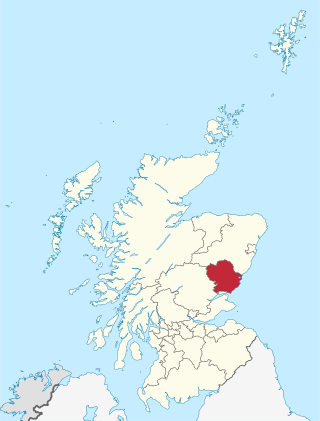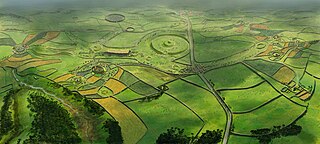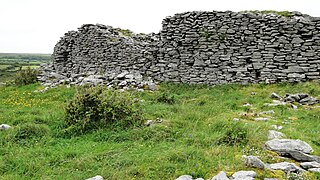
Angus is one of the 32 local government council areas of Scotland, a registration county and a lieutenancy area. The council area borders Aberdeenshire, Dundee City and Perth and Kinross. Main industries include agriculture and fishing. Global pharmaceuticals company GSK has a significant presence in Montrose in the east of the county.

A crannog is typically a partially or entirely artificial island, usually built in lakes and estuarine waters of Scotland, Wales, and Ireland. Unlike the prehistoric pile dwellings around the Alps, which were built on the shores and not inundated until later, crannogs were built in the water, thus forming artificial islands.

Chysauster Ancient Village is a late Iron Age and Romano-British village of courtyard houses in Cornwall, England, United Kingdom, which is currently in the care of English Heritage. The village included eight to ten houses, each with its own internal courtyard. To the south east is the remains of a fogou, an underground structure of uncertain function.

A fogou or fougou is an underground, dry-stone structure found on Iron Age or Romano-British-defended settlement sites in Cornwall. The original purpose of a fogou is uncertain today. Colloquially called vugs, vows, foggos, giant holts, or fuggy holes in various dialects, fogous have similarities with souterrains or earth-houses of northern Europe and particularly Scotland, including Orkney. Fewer than 15 confirmed fogous have been found.

Carn Euny is an archaeological site near Sancreed, on the Penwith peninsula in Cornwall, United Kingdom. It consists of evidence of both Iron Age and post-Iron Age settlement, with excavation on the site showning activity at Carn Euny as early as the Neolithic period. The first timber huts there were built about 500 BC, and 400-500 years later were replaced by stone huts; the remains of which are still visible.

Rathcroghan is a complex of archaeological sites near Tulsk in County Roscommon, Ireland. It is identified as the site of Cruachan, the traditional capital of the Connachta, the prehistoric and early historic rulers of the western territory. The Rathcroghan Complex is a unique archaeological landscape with many references found in early Irish medieval manuscripts.

The court cairn or court tomb is a megalithic type of chambered cairn or gallery grave. During the period, 3900–3500 BC, more than 390 court cairns were built in Ireland and over 100 in southwest Scotland. The Neolithic monuments are identified by an uncovered courtyard connected to one or more roofed and partitioned burial chambers. Many monuments were built in multiple phases in both Ireland and Scotland and later re-used in the Early Bronze Age.

Cahercommaun, sometimes Cahercommane, is a triple stone ringfort on the south-east edge of the Burren area, in Kilnaboy, near the rural village of Carran, in County Clare, Ireland. It was built in the 9th century.

Alyth is a town in Perth and Kinross, Scotland, five miles northeast of Blairgowrie and about 17 miles northwest of Dundee. In 2016 the town had an estimated population of 2,400.

Dowth is a Neolithic passage tomb near the River Boyne in County Meath, Ireland. It is one of the three main tombs of the Brú na Bóinne World Heritage Site, along with Newgrange and Knowth. Its features align it with the other passage tombs, which date from around 3200 BC. Unlike its bigger neighbours, Dowth has mostly been left as a ruin, although its smaller inner chambers are largely intact. The Royal Irish Academy carried out a botched excavation in 1847, leaving a large crater in the mound that has never been repaired.

A hypogeum or hypogaeum is an underground temple or tomb.

Halliggye Fogou is one of many fogous in Cornwall, England, United Kingdom.
Headland Archaeology Ltd is a wholly owned subsidiary of the RSK Group. Headland provides archaeological services and heritage advice to the construction industry.

Prehistoric Orkney refers only to the prehistory of the Orkney archipelago of Scotland that begins with human occupation. Although some records referring to Orkney survive that were written during the Roman invasions of Scotland, “prehistory” in northern Scotland is defined as lasting until the start of Scotland's Early Historic Period.
Carlungie and Ardestie Earthhouses can be found in farmland north of Monifieth and Carnoustie. They date to the late Iron Age, from the 1st to 2nd centuries AD. They are examples of souterrains, probably used to store food.

Rennibister Earth House is an Iron Age underground structure known as a souterrain. It is located on the Mainland of Orkney, in Scotland. The monument was discovered in 1926 when a threshing machine caused the roof to collapse. During excavation, the skeletal remains of six adults and twelve children were uncovered. Historic Environment Scotland established the site as a scheduled monument in 1928.

An erdstall is a type of tunnel found across Europe. They are of unknown origin but are believed to date from the Middle Ages. A variety of purposes have been theorized, including that they were used as escape routes or hiding places, but the most prominent theory is that they served a religious or spiritual purpose.

Creevykeel Court Tomb is one of the finest examples of a court tomb remaining in Ireland. The monument is located in the N15 Donegal to Sligo road, 50 meters north of Creevykeel cross-roads close to Cliffoney village in County Sligo. The original name for the Creevykeel monument is Caiseal an Bhaoisgin, the Fort of Bhaoisgin, Tobar an Bhaoisgin being the name of the well near the cairn. A second megalithic monument existed 300 meters to the north, but it was demolished around 1890.

Donaghmore Souterrain is a souterrain and National Monument located in County Louth, Ireland.

Aghnaskeagh Cairns is a chambered cairn and portal tomb forming a national monument in County Louth, Ireland.



















